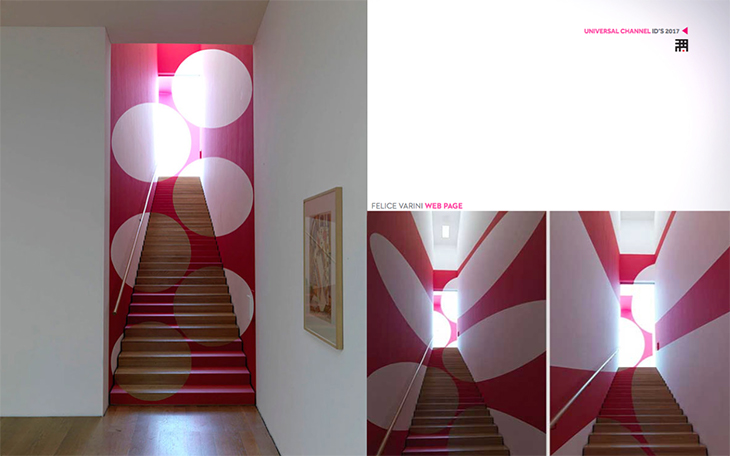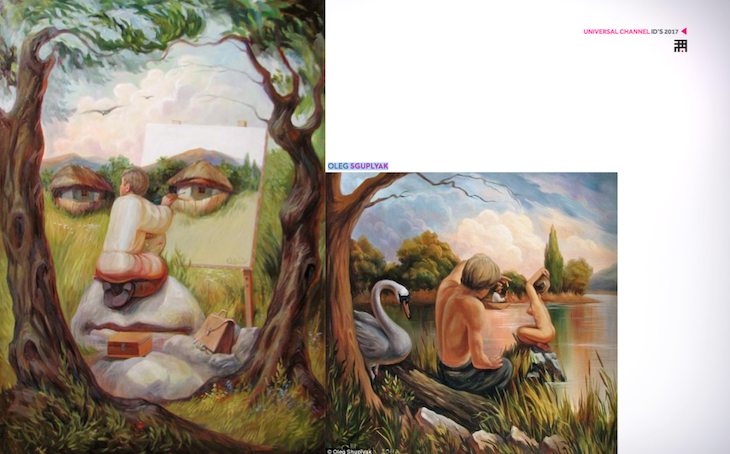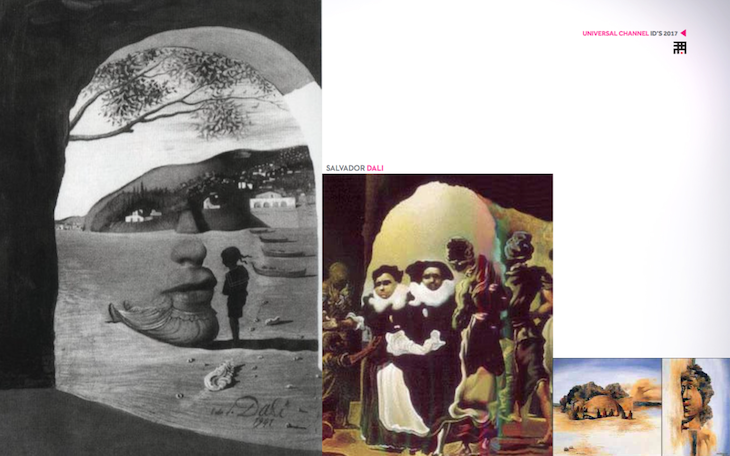Venezuelan studios Totuma and 2382.co — based in Miami and Madrid, respectively — experimented with different types of media and materials to build the artistic installations that were used as IDs for Universal Channel Latin America’s “100% characters” campaign.
RELATED: It’s All About Personality for Universal Channel Latin America
The pieces used visual tricks with optical effects and depth of field to create portraits of four main characters from the channel’s series: Chicago P.D.’s Hank Voight (Jason Beghe); Law & Order: Special Victims Unit’s Olivia Benson (Mariska Hargitay); Shades of Blue’s Harlee Santos (Jennifer Lopez); and Chicago Fire’s Kelly Severide (Taylor Kinney).
The project expanded upon previous versions created in Europe and the United States where elements such as coal, china and fake blood were applied to a flat surface to draw the faces of characters such as Norman Bates of Bates Motel and Kelly Severide of Chicago Fire.
“We were asked to take what had been done initially and give it a twist,” says Hubert Reinfeld, creative director at Totuma, the studio that conceptualized the idea. “We wanted our proposal to be in sync with the previous work, but also endowed with its own personality.”
One of the main challenges was working within a small budget, especially compared to the massive TV marketing budget of many of the network’s U.S. or European competitors. For example, one such installation featured a team lighting up a field with torches in the form of the face of Chicago Fire‘s Severide and then filming it from above.
Turning to Artists for Inspiration
The studios researched many different artists for inspiration, but were heavily influenced by French artist Bernard Pras, who creates portraits and images out of everyday household objects. He’s known for using all types of items—such as toys, cans, fruit, leaves and tiny objects—to recreate famous works of art such as Claude Monet’s Stormy Sea in Étretat, as well as for constructing pictures that depict historical figures such as Albert Einstein.
The studios also looked at Japanese designer Shigeo Fukuda, a master of optical illusions known for creating sculptures whose shadows depict figures such as people, ships and motorcycles.
Another major influence was the documentary Waste Land, directed by Lucy Walker, that follows contemporary artist Vik Muniz as he travels to the world’s largest garbage dump in his native Brazil, to photograph and create larger-than-life images of the garbage pickers there.
The studios also studied Swiss artist Felice Varini, and her dedication to geometric figures.
“At the time, we thought of using the circle in Universal Channel’s logo, and distorting it, so that its circular shape could only be seen from a certain angle,” says Reinfeld.

Other influencers included Portuguese artist Artur Bordalo, who creates animal sculptures from materials in junk yards; Ukranian painter Oleg Shuplyak, who conceals faces within images of nature; and prominent Spanish surrealist Salvador Dalí.


The creative team also analyzed TV-station logos, such as these idents from the UK’s Channel 4:
Producing the IDs
“Our job was to figure out how these great resources could be interpreted so they’d be viable at a production level within the limited budget,” says Luis Montenegro Lafont, director and founder of 2382.co. “We got to work on a solution that allowed us to combine Bernard Pras’s ‘objecthood’ with the idea of drawing on flat surfaces. The concept we received from Totuma suggested a 3D design that was space-related and centered on the impact of revealing a character little by little, with the [camera] path shaping the final picture.”
“We needed someone who was not only able to construct the sculptures but able to do so on a scale ideal for shooting, meaning on a set large enough for these pieces to be assembled, disassembled or moved, in addition to being able to position the camera around each sculpture,” says Reinfeld.
For the campaign, the characters were determined based on the channel’s programming priorities, so the next step was to choose images that would serve as each portrait’s foundation.
“We needed to identify the features of each character, but it was very important to increase the objects’ volume and add texture to the picture so that the final result was not just a mere painting. After several swaps, we reached a balance between painting and three-dimensional objects that brought richness to the path of the camera ,” says Vladimir Mihalkov, a creative director at Totuma.
The materials were divided into two groups. Objects from the series that were featured on screen and characteristic of each show—such as a fire helmet, torch, police badge or gun—were placed in the foreground. The remaining elements used to complete the construction of the character—such as baskets, chairs, clothes, electronic gadgets, carpets, ornaments and garbage—were placed in the background and sometimes shared across all four sculptures.
“This was a decision from production to reduce costs, as well as assembly and disassembly times, although in the development process we realized that since we were depicting three policemen and a fireman, there were connections among them. It was a play between images and their meanings,” says Montenegro.
In the end, the sculptures captured the personalities of each character, with the objects highlighting key aspects of their roles.
The Four Installations
For example, in the ID for Chicago P.D.’s sergeant Hank Voight, the broken glass evokes his violent nature and questionable procedures.
For the Law & Order: Special Victims Unit ID, the close-up objects include Det. Benson’s crime scene evidence kit and her badge.
The main item used to represent police officer Harlee Santos in Shades of Blue was a banknote floating amongst the artwork, symbolizing the corruption and the constant internal dichotomy that entraps the character.
For Chicago Fire’s Severide, the emphasis is on the helmet, the torch and a fire axe, in addition to other objects engulfed in ashes and smoke, as well as a flame that flares up at the piece’s conclusion.
When the elements used to distinguish the characters were exhausted, the creative team turned to the cities where each series takes place. For example, with Benson the team turned to a map of New York City, with steam billowing from the city’s drains.
Balance of Cultures
One of the challenges revolved around filming, and having to shoot the four installations and the physical logo on chroma key in only two days.
“We designed a system that allowed us to assemble and disassemble each sculpture in record time, mimicking Formula 1 pits. The mounting of each sculpture was, in a way, a performance,” says Caroline Heredia, executive producer at 2382.co.
In addition, Hurricane Irma prevented Reinfeld and Mihalkov from traveling to Madrid for shooting, so Totuma’s director, Juan Enis, was put in charge on location, while the two executives supervised via Skype.
Totuma is convinced that the connection with Spain-based 2382.co was a key decision for the project.
“We were drawn to the country, not only because of its talent but also for its competitive prices since the worldwide [economic] crisis of 2008,” says Mihalkov.
Meanwhile, 2382.co considers Latin America an interesting region in terms of its market and identity, where the transition towards a ‘new television’ is possible.
“Latin America is our natural market,” says Heredia. “What we liked about this project is that the production stage had a lot of improvisation but not necessarily in the ‘Latin American’ way, but in the more ‘European’ style of designed improvisation. The staging of these sculptures is all about that; it seems like free elaboration but that process takes place within strict guidelines.”
“This work,” says Montenegro, “implies a balance between the freestyle methods of Latin America and a more structured European approach. the Latin American disorder and the European order.”
Spanish version:













































__twocolumncontent.jpg)











